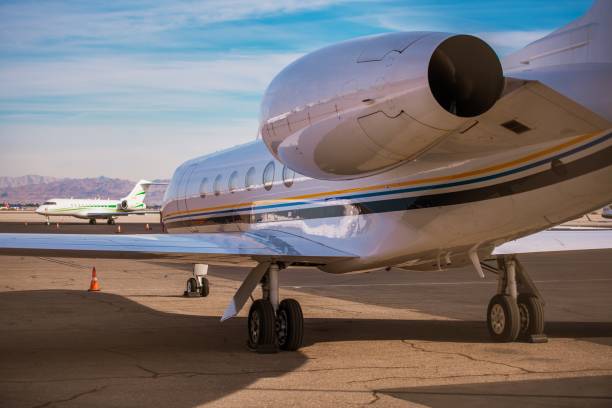ParaFlight vs In-House Air Services: Why Aviation Brokering is the Smart Choice for Business

The business aviation industry continues to evolve rapidly, with the global business jet market valued at USD 46.51 billion in 2024 and projected to reach USD 67.68 billion by 2032, exhibiting a CAGR of 4.99%. As companies increasingly recognize the strategic value of air transportation, they face a critical decision: should they build internal aviation capabilities or partner with a professional aviation broker like ParaFlight?
The evidence overwhelmingly favors the brokering approach. This comprehensive analysis explores why partnering with ParaFlight through FAA-certified operators delivers superior value, flexibility, and cost-effectiveness compared to maintaining in-house air services.
The Current State of Business Aviation
North America is expected to hold the largest share of the business jet market in 2024, primarily attributed to major business jet providers in the region. The market shows remarkable resilience, with Q2 2024 departures remaining 14 percent higher than in Q2 2019, continuing a trend that began in 2023 when departures were 15.1 percent higher than in 2019.
However, this growth introduces significant complexity. With thousands of charter operators worldwide and over 5,000 airports in the United States serving general aviation, navigating the aviation landscape requires specialized expertise that most companies simply cannot develop internally.
Understanding Your Options: In-House vs. ParaFlight Brokering
The In-House Challenge
In-house air services typically involve companies establishing their own aviation departments with dedicated staff, aircraft procurement or leasing arrangements, and internal management systems. While this approach may appeal to organizations viewing aviation as a core function, it presents substantial challenges:
Personnel Requirements: Aviation professionals command premium salaries, with flight operations managers earning an average of $95,000 annually and chief pilots commanding $150,000 or more. These figures don't include benefits, training, and ongoing certification maintenance costs.
Regulatory Complexity: Aviation compliance demands dedicated resources for maintaining certificates, conducting safety audits, and staying current with ever-changing regulations. The complexity spans over 12,000 pages of documentation according to industry sources, with frequent updates and amendments.
Limited Scalability: In-house operations must size for peak demand, leading to underutilization during slower periods. Industry data shows that for the first time in more than a decade, the general aviation manufacturing industry has eclipsed 4,000 aircraft delivered, yet many corporate-owned aircraft average only 300 flight hours annually.
The ParaFlight Advantage: Professional Aviation Brokering
ParaFlight represents a more strategic approach, partnering exclusively with FAA-certified operators to serve as your aviation solution provider. We leverage industry expertise, established relationships, and market knowledge to secure optimal solutions for each client's specific needs while maintaining the highest safety standards.
Important Disclosure: ParaFlight partners exclusively with FAA-certified operators and does not directly manage flights, employ crews, provide medical care, or own transport assets. Our role is to connect you with the right certified operators who can safely and efficiently meet your aviation needs.
Financial Analysis: The Cost Advantage of Brokering
Hidden Costs of In-House Operations
Business aircraft have a safety record that is comparable to that of the major airlines, but achieving this level of safety through in-house operations requires substantial investment beyond aircraft acquisition costs:
Infrastructure Investment: Establishing in-house capabilities often requires significant upfront investments in office space, communication systems, and specialized software platforms.
Compliance Costs: Maintaining regulatory compliance requires ongoing investment in training, audits, and system updates. Non-compliance can result in significant penalties and operational disruptions.
Underutilization Risk: Companies must invest in capabilities sized for peak demand, resulting in costly underutilization during normal periods.
ParaFlight's Cost-Transparent Model
ParaFlight's brokering model eliminates overhead expenses while delivering superior cost transparency. By working with a network of FAA-certified operators, we can negotiate favorable rates that individual companies typically cannot achieve independently.
Industry estimates suggest that companies using aviation brokers can achieve cost savings of 15-30% compared to managing aviation services in-house, while gaining access to a broader range of aircraft types and service providers through certified operators.
Flexibility and Access: Meeting Dynamic Business Needs
Overcoming In-House Limitations
In-house operations face inherent scalability challenges. Industry data shows these aircraft will boost total flying hours by about 6%, with the vast majority of operators – 93% - expecting to fly at least as much in 2024 as they did in 2023, with 29% planning to log even more hours in the air.
Despite this growing demand, in-house operations struggle with:
- Geographic limitations and restricted operator networks
- Limited aircraft type availability
- Difficulty scaling during peak demand periods
- Challenges accessing specialized services or international markets
ParaFlight's Scalable Network Solution
ParaFlight's extensive network of FAA-certified operators provides unparalleled flexibility. Whether clients need a light jet for regional travel or a heavy jet for international trips, we can source appropriate aircraft from our network of certified operators.
This scalability extends beyond aircraft selection. During peak travel periods, ParaFlight can coordinate multiple flights across different regions through various certified operators, something virtually impossible for most in-house operations.
Safety and Expertise: The Professional Standard
The Complexity of Aviation Safety
Single pilot operations have enhanced risks when compared to multi-pilot operations, demonstrated by the fact that single-pilot aircraft are 30 percent more likely to be involved in an accident than aircraft with dual pilot crews. Single pilot operations are more susceptible to task saturation; when task saturation increases, so too does the number of errors.
Modern aviation operations involve intricate coordination across multiple stakeholders: pilots, ground handlers, fuel suppliers, customs officials, and maintenance providers. Each flight requires navigation of complex regulatory requirements that vary by jurisdiction.
ParaFlight's Safety-First Approach
ParaFlight maintains rigorous safety standards by partnering exclusively with FAA-certified operators who meet comprehensive vetting criteria:
- Operator Certification Verification: All recommended operators maintain current FAA certifications
- Safety Rating Assessment: Evaluation of third-party safety ratings and audit results
- Insurance Coverage Validation: Confirmation of appropriate insurance coverage levels
- Pilot Qualification Verification: Review of pilot credentials and training records
- Aircraft Maintenance Record Review: Assessment of maintenance compliance and history
This systematic approach to safety management provides clients with confidence while ensuring all operations are conducted by properly certified professionals.
Technology and Operational Efficiency
The Digital Challenge for In-House Operations
Modern aviation operations increasingly rely on sophisticated technology platforms for flight planning, scheduling, tracking, and reporting. Developing and maintaining these systems requires significant investment and specialized IT expertise that most companies cannot justify economically.
ParaFlight's Technology Platform
ParaFlight leverages advanced technology to deliver superior service efficiency and transparency through our proprietary platform, which provides clients with:
- Real-time flight coordination with certified operators
- Comprehensive trip reporting and expense management
- Mobile accessibility for booking and trip management
- Integration capabilities with corporate travel management systems
Future Innovation: We're closely monitoring emerging technologies such as artificial intelligence and advanced analytics that may enhance aviation coordination in the future, though these remain developmental rather than currently deployed solutions.
Market Intelligence and Professional Management
The Information Advantage
The overall 2024 general aviation shipments and billings, when compared to 2023, showed nearly all aircraft segments saw increases in shipments and aircraft deliveries were valued at $31.9 billion, an increase of 13.7%. Airplane shipments in 2024 saw piston airplane deliveries increase 4.2%, with 1,772 units; turboprop airplane deliveries decline by 1.9%, with 626 units; and business jet deliveries increase to 764 units from 730. The value of airplane deliveries for 2024 was $26.4 billion, an increase of 14.3%.
This dynamic market environment requires specialized knowledge and continuous monitoring that in-house operations typically cannot maintain cost-effectively.
ParaFlight's Market Expertise
ParaFlight employs certified aviation professionals who dedicate their careers to understanding market dynamics, regulatory requirements, and operational best practices. This specialization delivers several key advantages:
Market Intelligence: Real-time awareness of aircraft availability, pricing trends, and operator performance across markets through our network of FAA-certified operators.
Regulatory Expertise: Professional aviation brokers stay current with changing regulations, ensuring compliance across jurisdictions while minimizing client administrative burden.
Relationship Management: Established relationships with certified operators, airports, and service providers enable ParaFlight to secure priority access and negotiate favorable terms.
Environmental Responsibility and Sustainability
The Sustainability Imperative
Business aviation has a small carbon footprint and an exemplary environmental record. Aviation emissions are only a tiny fraction of all transportation emissions, and business aircraft emissions are a small portion of those. The industry has a long history of continually leveraging technology to minimize noise and emissions, while improving safety and efficiency.
Corporate sustainability initiatives increasingly focus on optimizing environmental impact, including business aviation operations.
ParaFlight's Environmental Leadership
ParaFlight actively promotes sustainable aviation practices through our network of FAA-certified operators by:
- Aircraft selection optimization for fuel efficiency
- Route planning coordination to minimize environmental impact
- Partnership with operators investing in sustainable aviation fuels
- Carbon offset program coordination
- Comprehensive reporting capabilities to support corporate sustainability goals
24/7 Support and Service Excellence
Round-the-Clock Requirements
Aviation needs don't follow standard business hours. Flight delays, weather disruptions, and last-minute itinerary changes require immediate attention and expert problem-solving capabilities.
Maintaining round-the-clock in-house support requires significant staffing investments and operational complexity that most companies cannot justify economically.
ParaFlight's Dedicated Support
ParaFlight provides 24/7/365 support through dedicated trip coordinators who understand each client's preferences, requirements, and corporate policies. This personalized service level ensures consistent execution while maintaining cost efficiency through shared resource allocation across our client base.
Industry Growth and Market Dynamics
Current Market Trends
Based on survey results, Honeywell forecasts up to 8,500 new business jets worth $280 billion will be delivered over the next decade, an increase in value from last year's forecast. However, the five-year new jet purchase plans of business aviation operators surveyed remained on par with last year's results, indicating that demand for new aircraft is stabilizing well above pre-pandemic levels. In addition, the survey reveals ongoing plans by business jet manufacturers to ramp up production in response to strong backlogs and stable book-to-bill ratios persisting through 2024.
This sustained growth creates both opportunities and challenges for companies requiring aviation services.
Positioning for Growth
Companies partnering with professional brokers like ParaFlight position themselves to adapt quickly to new technologies, regulations, and market opportunities. Rather than investing scarce resources in building internal aviation capabilities, forward-thinking organizations recognize that partnering with specialists delivers better outcomes at lower costs.
Real-World Applications and Case Examples
Mid-Market Manufacturing Success
A $500 million manufacturing company previously maintained internal aviation coordination with two full-time employees and relationships with three charter operators. After partnering with ParaFlight, the company achieved:
- Estimated 25% cost reduction through improved rate negotiation with FAA-certified operators
- Access to 50+ aircraft types through our certified operator network versus previous 8 options
- Elimination of two full-time positions and associated overhead
- Improved trip completion reliability through our comprehensive operator network
Note: Results are estimates based on typical client experiences and may vary.
Healthcare System Efficiency
A regional healthcare system required frequent air transportation coordination for time-sensitive medical missions. ParaFlight's solution delivered:
- Estimated 40% improvement in aircraft availability for urgent missions through our certified operator network
- Expanded geographic coverage to serve rural facilities
- 24/7 medical transport coordination capabilities
- Comprehensive billing and reporting for insurance reimbursement
Note: Results are estimates based on client feedback and may vary depending on specific requirements.
Making the Strategic Decision
Evaluation Framework
Companies considering their aviation service approach should evaluate several key factors:
Volume Analysis: Companies with fewer than 200 flight hours annually typically benefit most from brokering services, while those exceeding 400 hours might consider hybrid approaches.
Geographic Requirements: Organizations with diverse geographic needs favor brokering for network advantages through certified operators.
Cost Sensitivity: Budget-conscious organizations benefit from brokering's transparent, usage-based pricing model.
Risk Management: Companies preferring to focus on core business activities while transferring aviation coordination complexity benefit from professional brokering services.
The ParaFlight Solution
ParaFlight's comprehensive approach addresses every aspect of aviation service coordination through our network of FAA-certified operators:
- Cost Optimization: Transparent pricing with no hidden fees
- Global Coverage: Access to worldwide network of certified operators
- Expert Management: Professional aviation specialists handling all coordination
- Technology Integration: Modern platforms for booking, tracking, and reporting
- Safety Assurance: Rigorous operator vetting and ongoing monitoring through FAA-certified partners
- Sustainability Focus: Environmental impact optimization and reporting coordination
The Clear Choice for Modern Businesses
The evidence strongly supports aviation brokering as the superior choice for most organizations. ParaFlight's specialized expertise, cost advantages, and comprehensive service delivery through FAA-certified operators eliminate the complexities and risks associated with in-house aviation management while providing superior flexibility and service levels.
In the U.S., General Aviation flies over 28.6 million hours, of which two-thirds are for business, demonstrating the critical role aviation plays in modern commerce. As the aviation industry continues evolving, companies partnering with professional brokers like ParaFlight position themselves to adapt quickly to new technologies, regulations, and market opportunities.
The question isn't whether your company needs aviation services—it's whether you can afford the inefficiencies and risks of managing them internally. ParaFlight's proven track record, combined with the compelling economic advantages of professional brokering through FAA-certified operators, makes the choice clear.
For organizations ready to optimize their aviation strategy, ParaFlight offers the expertise, certified operator network, and technology platform necessary to transform air transportation from a logistical challenge into a competitive advantage.
ParaFlight partners exclusively with FAA-certified operators and does not directly manage flights, employ crews, provide medical care, or own transport assets. All flight operations are conducted by properly certified aviation professionals.
References
- Fortune Business Insights. "Business Jet Market Size, Share, Trends | Growth Report [2032]." https://www.fortunebusinessinsights.com/industry-reports/business-jet-market-101585
- NBAA - National Business Aviation Association. "2024 NBAA Top Safety Focus Areas." https://nbaa.org/aircraft-operations/safety/2024-nbaa-top-safety-focus-areas/
- General Aviation Manufacturers Association. "2024 Annual Data." https://gama.aero/facts-and-statistics/statistical-databook-and-industry-outlook/annual-data/
- Honeywell. "Honeywell Forecast Shows Increased Demand for New Business Jets, Stable Growth for Next Decade." https://www.honeywell.com/us/en/press/2024/10/honeywell-forecast-shows-increased-demand-for-new-business-jets-stable-growth-for-next-decade
- NBAA - National Business Aviation Association. "Business Aviation: Just the Facts." https://nbaa.org/business-aviation/business-aviation-just-the-facts/















